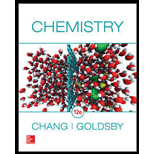
Concept explainers
(a)
Interpretation:
The number of protons and neutrons that are present in the given nucleus of noble gases has to be determined.
(a)
Answer to Problem 2.89QP
The total number of protons and neutrons present is:
Explanation of Solution
Element symbol is given as
Element symbol given is
From the given symbol, it is found that the mass number is 4 and atomic number is 2. This means the total number of protons present is 2. Number of neutrons present in the nucleus can be calculated by finding the difference between mass number and atomic number.
In the helium atom, the atomic number 2 is equal to protons number and the differences between the mass number and proton number gives the neutron number 2.
Element symbol given is
From the given symbol, it is found that the mass number is 20 and atomic number is 10. This means the total number of protons present is 10. Number of neutrons present in the nucleus can be calculated by finding the difference between mass number and atomic number.
In the neon atom, the atomic number 10 is equal to protons number and the differences between the mass number and proton number gives the number of neutrons as 10.
Element symbol given is
From the given symbol, it is found that the mass number is 40 and atomic number is 18. This means the total number of protons present is 18. Number of neutrons present in the nucleus can be calculated by finding the difference between mass number and atomic number.
In the argon atom, the atomic number 18 is equal to protons number and the differences between the mass number and proton number gives the number of neutrons as 22.
Element symbol given is
From the given symbol, it is found that the mass number is 84 and atomic number is 36. This means the total number of protons present is 36. Number of neutrons present in the nucleus can be calculated by finding the difference between mass number and atomic number.
In the krypton atom, the atomic number 36 is equal to protons number and the differences between the mass number and proton number gives the number of neutrons as 48.
Element symbol given is
From the given symbol, it is found that the mass number is 132 and atomic number is 54. This means the total number of protons present is 54. Number of neutrons present in the nucleus can be calculated by finding the difference between mass number and atomic number.
In the xenon atom, the atomic number 54 is equal to protons number and the differences between the mass number and proton number gives the number of neutrons as 78.
Number of protons and neutrons present in the given noble gases are determined.
(b)
Interpretation:
The ratio of neutrons to protons along with their respective numbers in the nucleus of each atom to be identified.
(b)
Answer to Problem 2.89QP
Neutron to proton ratio for noble gases is:
As the atomic number increases, the neutron to proton ratio also increases.
Explanation of Solution
Analyze the ratio of neutrons to protons for each element.
The ratio of neutron to proton is increasing down the group along with increasing the atomic number.
Want to see more full solutions like this?
Chapter 2 Solutions
Chemistry
- Can I get helpp drawing my arrowsarrow_forwardWhich of the m/z values corresponds to the base peak in the mass spectrum shown? 100 80 A. 45 B. 44 C. 29 D. 15 Intensity 20 0 10 20 30 40 B- m/z -8 50 E. 30 Which of the m/z values correspond to the molecular ion for the compound shown? A. 18 B. 82 OH C. 100 D. 102 E. 103arrow_forwardCan someone help me with drawing my arrows.arrow_forward
- I'm having trouble with converting lewis diagrams into VSEPR diagrams. I currently have this example of C2BrCl3 which I want to turn into a lewis structure, but I'm not sure what steps I need to do in order to do so. I have the table written down, however, there's two central atoms so what would I do? There seems to be 4 electron domains on the carbon atom and no lone pairs so it would seem like this shape would be tetrahedral. Here's what I have now. Thanks!arrow_forwardWe discussed the solid phase resin using in peptide synthesis. Provide a mechanism, for its formation. DRAW THE MECHANISM.arrow_forwardPlease help. Every time I've asked an expert in the past, it's been wrong :(arrow_forward
 General Chemistry - Standalone book (MindTap Cour...ChemistryISBN:9781305580343Author:Steven D. Gammon, Ebbing, Darrell Ebbing, Steven D., Darrell; Gammon, Darrell Ebbing; Steven D. Gammon, Darrell D.; Gammon, Ebbing; Steven D. Gammon; DarrellPublisher:Cengage Learning
General Chemistry - Standalone book (MindTap Cour...ChemistryISBN:9781305580343Author:Steven D. Gammon, Ebbing, Darrell Ebbing, Steven D., Darrell; Gammon, Darrell Ebbing; Steven D. Gammon, Darrell D.; Gammon, Ebbing; Steven D. Gammon; DarrellPublisher:Cengage Learning Chemistry: The Molecular ScienceChemistryISBN:9781285199047Author:John W. Moore, Conrad L. StanitskiPublisher:Cengage Learning
Chemistry: The Molecular ScienceChemistryISBN:9781285199047Author:John W. Moore, Conrad L. StanitskiPublisher:Cengage Learning Chemistry & Chemical ReactivityChemistryISBN:9781337399074Author:John C. Kotz, Paul M. Treichel, John Townsend, David TreichelPublisher:Cengage Learning
Chemistry & Chemical ReactivityChemistryISBN:9781337399074Author:John C. Kotz, Paul M. Treichel, John Townsend, David TreichelPublisher:Cengage Learning Chemistry & Chemical ReactivityChemistryISBN:9781133949640Author:John C. Kotz, Paul M. Treichel, John Townsend, David TreichelPublisher:Cengage Learning
Chemistry & Chemical ReactivityChemistryISBN:9781133949640Author:John C. Kotz, Paul M. Treichel, John Townsend, David TreichelPublisher:Cengage Learning Introductory Chemistry: A FoundationChemistryISBN:9781337399425Author:Steven S. Zumdahl, Donald J. DeCostePublisher:Cengage Learning
Introductory Chemistry: A FoundationChemistryISBN:9781337399425Author:Steven S. Zumdahl, Donald J. DeCostePublisher:Cengage Learning Chemistry: Principles and PracticeChemistryISBN:9780534420123Author:Daniel L. Reger, Scott R. Goode, David W. Ball, Edward MercerPublisher:Cengage Learning
Chemistry: Principles and PracticeChemistryISBN:9780534420123Author:Daniel L. Reger, Scott R. Goode, David W. Ball, Edward MercerPublisher:Cengage Learning





